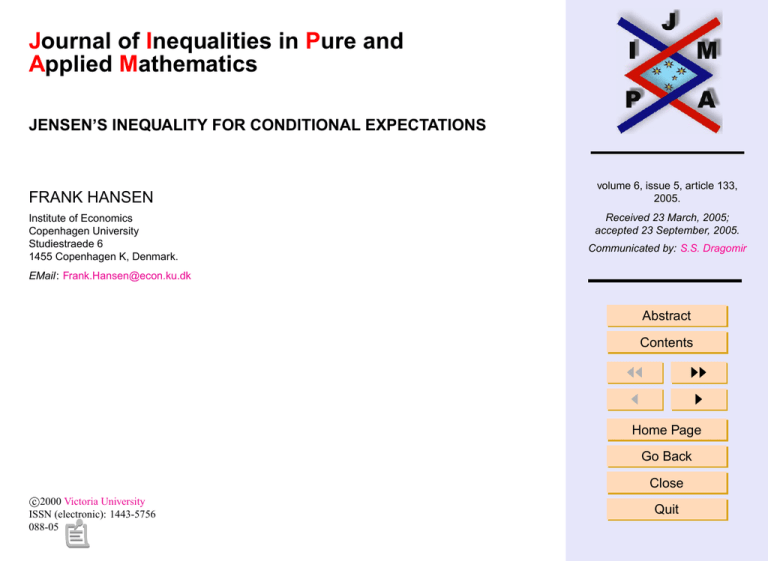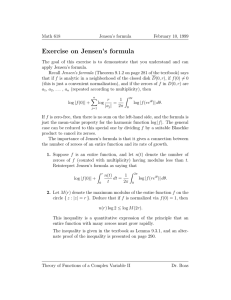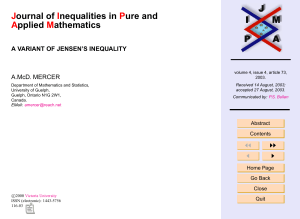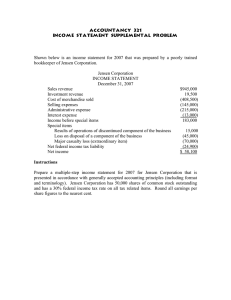J I P A
advertisement

Journal of Inequalities in Pure and
Applied Mathematics
JENSEN’S INEQUALITY FOR CONDITIONAL EXPECTATIONS
FRANK HANSEN
Institute of Economics
Copenhagen University
Studiestraede 6
1455 Copenhagen K, Denmark.
volume 6, issue 5, article 133,
2005.
Received 23 March, 2005;
accepted 23 September, 2005.
Communicated by: S.S. Dragomir
EMail: Frank.Hansen@econ.ku.dk
Abstract
Contents
JJ
J
II
I
Home Page
Go Back
Close
c
2000
Victoria University
ISSN (electronic): 1443-5756
088-05
Quit
Abstract
We study conditional expectations generated by an abelian C ∗ -subalgebra in
the centralizer of a positive functional. We formulate and prove Jensen’s inequality for functions of several variables with respect to this type of conditional
expectations, and we obtain as a corollary Jensen’s inequality for expectation
values.
Jensen’s Inequality for
Conditional Expectations
2000 Mathematics Subject Classification: 47A63, 26A51.
Key words: Trace function, Jensen’s inequality, Conditional expectation.
Frank Hansen
This paper is based on the talk given by the author within the “International
Conference of Mathematical Inequalities and their Applications, I”, December 0608, 2004, Victoria University, Melbourne, Australia [http://rgmia.vu.edu.au/
conference]
Title Page
Contents
JJ
J
Contents
1
Preliminaries . . . . . . . . . . . . . . . . . . . . . . . . . . . . . . . . . . . . . . . .
2
Conditional Expectations . . . . . . . . . . . . . . . . . . . . . . . . . . . . . .
3
Jensen’s inequality . . . . . . . . . . . . . . . . . . . . . . . . . . . . . . . . . . .
References
3
4
6
II
I
Go Back
Close
Quit
Page 2 of 12
J. Ineq. Pure and Appl. Math. 6(5) Art. 133, 2005
http://jipam.vu.edu.au
1.
Preliminaries
An n-tuple x = (x1 , . . . , xn ) of elements in a C ∗ -algebra A is said to be abelian
if the elements x1 , . . . , xn are mutually commuting. We say that an abelian ntuple x of self-adjoint elements is in the domain of a real continuous function
f of n variables defined on a cube of real intervals I = I1 × · · · × In if the
spectrum σ(xi ) of xi is contained in Ii for each i = 1, . . . , n. In this situation
f (x) is naturally defined as an element in A in the following way. We may
assume that A is realized as operators on a Hilbert space and let
Z
xi = λ dEi (λ)
i = 1, . . . , n
denote the spectral resolutions of the operators x1 , . . . , xn . Since the n-tuple
x = (x1 , . . . , xn ) is abelian, the spectral measures E1 , . . . , En are mutually
commuting. We may thus set
E(S1 × · · · × Sn ) = E1 (S1 ) · · · En (Sn )
for Borel sets S1 , . . . , Sn in R and extend E to a spectral measure on Rn with
support in I. Setting
Z
f (x) = f (λ1 , . . . , λn ) dE(λ1 , . . . , λn )
Jensen’s Inequality for
Conditional Expectations
Frank Hansen
Title Page
Contents
JJ
J
II
I
Go Back
Close
Quit
Page 3 of 12
and since f is continuous, we finally realize that f (x) is an element in A.
J. Ineq. Pure and Appl. Math. 6(5) Art. 133, 2005
http://jipam.vu.edu.au
2.
Conditional Expectations
Let C be a separable abelian C ∗ -subalgebra of a C ∗ -algebra A, and let ϕ be a
positive functional on A such that C is contained in the centralizer
Aϕ = {y ∈ A | ϕ(xy) = ϕ(yx) ∀x ∈ A}.
The subalgebra is of the form C = C0 (S) for some locally compact metric space
S.
Jensen’s Inequality for
Conditional Expectations
Theorem 2.1. There exists a positive linear mapping
Φ : M (A) → L∞ (S, µϕ )
(2.1)
Frank Hansen
on the multiplier algebra M (A) such that
Φ(xy) = Φ(yx) = Φ(x)y,
x ∈ M (A), y ∈ C
Title Page
Contents
almost everywhere, and a finite Radon measure µϕ on S such that
Z
z(s)Φ(x)(s) dµϕ (s) = ϕ(zx),
z ∈ C, x ∈ M (A).
JJ
J
II
I
S
Proof. By the Riesz representation theorem there is a finite Radon measure µϕ
on S such that
Z
ϕ(y) =
y(s) dµϕ (s),
y ∈ C = C0 (S).
Go Back
Close
Quit
Page 4 of 12
S
For each positive element x in the multiplier algebra M (A) we have
J. Ineq. Pure and Appl. Math. 6(5) Art. 133, 2005
0 ≤ ϕ(yx) = ϕ(y 1/2 xy 1/2 ) ≤ kxkϕ(y),
y ∈ C+ .
http://jipam.vu.edu.au
The functional y → ϕ(yx) on C consequently defines a Radon measure on S
which is dominated by a multiple of µϕ , and it is therefore given by a unique element Φ(x) in L∞ (S, µϕ ). By linearization this defines a positive linear mapping
defined on the multiplier algebra
Φ : M (A) → L∞ (S, µϕ )
(2.2)
such that
Z
z ∈ C, x ∈ M (A).
z(s)Φ(x)(s) dµϕ (s) = ϕ(zx),
Jensen’s Inequality for
Conditional Expectations
S
Frank Hansen
Furthermore, since
Z
Z
z(s)Φ(yx)(s) dµϕ (s) = ϕ(zyx) =
z(s)y(s)Φ(x)(s) dµϕ (s)
S
S
for x ∈ M (A) and z, y ∈ C we derive Φ(yx) = yΦ(x) = Φ(x)y almost
everywhere. Since C is contained in the centralizer Aϕ and thus ϕ(zxy) =
ϕ(yzx), we similarly obtain Φ(xy) = Φ(x)y almost everywhere.
Note that Φ(z)(s) = z(s) almost everywhere in S for each z ∈ C, cf. [6,
4, 5]. With a slight abuse of language we call Φ a conditional expectation even
though its range is not a subalgebra of M (A).
Title Page
Contents
JJ
J
II
I
Go Back
Close
Quit
Page 5 of 12
J. Ineq. Pure and Appl. Math. 6(5) Art. 133, 2005
http://jipam.vu.edu.au
3.
Jensen’s inequality
Following the notation in [5] we consider a separable C ∗ -algebra A of operators
on a (separable) Hilbert space H, and a field (at )t∈T of operators in the multiplier
algebra
M (A) = {a ∈ B(H) | aA + Aa ⊆ A}
defined on a locally compact metric space T equipped with a Radon measure ν.
We say that the field (at )t∈T is weak*-measurable if the function t → ϕ(at ) is
ν-measurable on T for each ϕ ∈ A∗ ; and we say that the field is continuous if
the function t → at is continuous [4].
As noted in [5] the field (at )t∈T is weak*-measurable, if and only if for each
vector ξ ∈ H the function t → at ξ is weakly (equivalently strongly) measurable.
In particular, the composed field (a∗t bt )t∈T is weak*-measurable if both (at )t∈T
and (bt )t∈T are weak*-measurable fields.
If for a weak*-measurable field (at )t∈T the function t → |ϕ(at )| is integrable
for every state ϕ ∈ S(A) and the integrals
Z
|ϕ(at )| dν(t) ≤ K,
∀ϕ ∈ S(A)
T
are uniformly bounded by some constant K, then there is a unique element
(a C ∗ -integral in Pedersen’s terminology [8, 2.5.15]) in the multiplier algebra
M (A), designated by
Z
at dν(t),
Jensen’s Inequality for
Conditional Expectations
Frank Hansen
Title Page
Contents
JJ
J
II
I
Go Back
Close
Quit
Page 6 of 12
T
such that
J. Ineq. Pure and Appl. Math. 6(5) Art. 133, 2005
http://jipam.vu.edu.au
Z
ϕ
Z
at dν(t) =
ϕ(at ) dν(t),
T
∀ϕ ∈ A∗ .
T
We say in this case that the field (at )t∈T is integrable. Finally we say that a field
(at )t∈T is a unital column field [1, 4, 5], if it is weak*-measurable and
Z
a∗t at dν(t) = 1.
T
We note that a C ∗ -subalgebra of a separable C ∗ -algebra is automatically separable.
Theorem 3.1. Let C be an abelian C ∗ -subalgebra of a separable C ∗ -algebra
A, ϕ be a positive functional on A such that C is contained in the centralizer
Aϕ and let
Φ : M (A) → L∞ (S, µϕ )
be the conditional expectation defined in (2.1). Let furthermore f : I → R be a
continuous convex function of n variables defined on a cube, and let t → at ∈
M (A) be a unital column field on a locally compact Hausdorff space T with a
Radon measure ν. If t → xt is an essentially bounded, weak*-measurable field
on T of abelian n-tuples of self-adjoint elements in A in the domain of f, then
Z
∗
(3.1)
at f (xt )at dν(t)
f (Φ(y1 ), . . . , Φ(yn )) ≤ Φ
T
almost everywhere, where the n-tuple y in M (A) is defined by setting
Z
y = (y1 , . . . , yn ) =
a∗t xt at dν(t).
T
Jensen’s Inequality for
Conditional Expectations
Frank Hansen
Title Page
Contents
JJ
J
II
I
Go Back
Close
Quit
Page 7 of 12
J. Ineq. Pure and Appl. Math. 6(5) Art. 133, 2005
http://jipam.vu.edu.au
Proof. The subalgebra C is as noted above of the form C = C0 (S) for some
locally compact metric space S, and since the C ∗ -algebra C0 (I) is separable we
may for almost every s in S define a Radon measure µs on I by setting
Z
Z
∗
µs (g) = g(λ) dµs (λ) = Φ
at g(xt )at dµ(t) (s),
g ∈ C0 (I).
T
I
Since
Z
µs (1) = Φ
a∗t at
dµ(t) = Φ(1) = 1
T
we observe that µs is a probability measure. If we put gi (λ) = λi then
Z
Z
∗
gi (λ) dµs (λ) = Φ
at xit at dµ(t) (s) = Φ(yi )(s)
I
T
Jensen’s Inequality for
Conditional Expectations
Frank Hansen
Title Page
for i = 1, . . . , n and since f is convex we obtain
Z
Z
f (Φ(y1 )(s), . . . , Φ(yn )(s)) = f
g1 (λ) dµs (λ), . . . , gn (λ) dµs (λ)
I
I
Z
≤ f (g1 (λ), . . . , gn (λ)) dµs (λ)
ZI
= f (λ) dµs (λ)
I
Z
∗
=Φ
at f (xt )at dµ(t) (s)
Contents
JJ
J
II
I
Go Back
Close
Quit
Page 8 of 12
T
for almost all s in S.
J. Ineq. Pure and Appl. Math. 6(5) Art. 133, 2005
http://jipam.vu.edu.au
The following corollary is known as “Jensen’s inequality for expectation
values”. It was formulated (for continuous fields) in the reference [3], where
a more direct proof is given.
Corollary 3.2. Let f : I → R be a continuous convex function of n variables
defined on a cube, and let t → at ∈ B(H) be a unital column field on a locally
compact Hausdorff space T with a Radon measure ν. If t → xt is a bounded
weak*-measurable field on T of abelian n-tuples of self-adjoint operators on H
in the domain of f, then
Z
∗
(3.2)
f (y1 ξ | ξ), . . . , (yn ξ | ξ) ≤
at f (xt )at dν(t)ξ | ξ
T
for any unit vector ξ ∈ H, where the n-tuple y is defined by setting
Z
y = (y1 , . . . , yn ) =
a∗t xt at dν(t).
T
Proof. The statement follows from Theorem 3.1 by choosing ϕ as the trace and
letting C be the C ∗ -algebra generated by the orthogonal projection P on the
vector ξ. Then C = C0 (S) where S = {0, 1}, and an element z ∈ C has the
representation
z = z(0)P + z(1)(1 − P ).
The measure dµϕ gives unit weight in each of the two points, and the conditional
expectation Φ is given by
(
(xξ | ξ)
s=0
Φ(x)(s) =
Tr(x − P x) s = 1.
Jensen’s Inequality for
Conditional Expectations
Frank Hansen
Title Page
Contents
JJ
J
II
I
Go Back
Close
Quit
Page 9 of 12
J. Ineq. Pure and Appl. Math. 6(5) Art. 133, 2005
http://jipam.vu.edu.au
Indeed,
ϕ(zx) = Tr z(0)P + z(1)(1 − P ) x
= z(0)Φ(x)(0) + z(1)Φ(x)(0)
Z
=
z(s)Φ(x)(s) ds
S
as required. The statement follows by evaluating the functions appearing on
each side of the inequality (3.1) at the point s = 0.
Remark 1. If we choose ν as a probability measure on T, then the trivial field
at = 1 for t ∈ T is unital and (3.2) takes the form
Z
Z
Z
f
x1t dν(t)ξ | ξ , . . . ,
xnt dν(t)ξ | ξ
≤
f (xt ) dν(t)ξ | ξ
T
T
T
for bounded weak*-measurable fields of abelian n-tuples xt = (x1t , . . . , xnt ) of
self-adjoint operators in the domain of f and unit vectors ξ. By choosing ν as
an atomic measure with one atom we get a version
(3.3)
f (x1 ξ | ξ) , . . . , (xn ξ | ξ) ≤ f (x)ξ | ξ
of the Jensen inequality by Mond and Pečarić [7]. By further considering a
direct sum
ξ=
m
M
j=1
ξj
and
x = (x1 , . . . , xn ) =
m
M
j=1
(x1j , . . . , xnj )
Jensen’s Inequality for
Conditional Expectations
Frank Hansen
Title Page
Contents
JJ
J
II
I
Go Back
Close
Quit
Page 10 of 12
J. Ineq. Pure and Appl. Math. 6(5) Art. 133, 2005
http://jipam.vu.edu.au
we obtain the familiar version
f
m
X
j=1
(x1j ξj | ξj ), . . . ,
m
X
j=1
!
(xnj ξj | ξj )
≤
m X
f (x1j , . . . , xnj )ξj | ξj
j=1
valid for abelian n-tuples (x1j , . . . , xnj ), j = 1, . . . , m of self-adjoint operators
in the domain of f and vectors ξ1 , . . . , ξm with kξ1 k2 + · · · + kξm k2 = 1.
Jensen’s Inequality for
Conditional Expectations
Frank Hansen
Title Page
Contents
JJ
J
II
I
Go Back
Close
Quit
Page 11 of 12
J. Ineq. Pure and Appl. Math. 6(5) Art. 133, 2005
http://jipam.vu.edu.au
References
[1] H. ARAKI AND F. HANSEN, Jensen’s operator inequality for functions
of several variables, Proc. Amer. Math. Soc., 128 (2000), 2075–2084.
[2] L.G. BROWN AND H. KOSAKI, Jensen’s inequality in semi-finite von
Neumann algebras, J. Operator Theory, 23 (1990), 3–19.
[3] F. HANSEN, Monotone trace functons of several variables, International
Journal of Mathematics, 16 (2005), 777–785.
[4] F. HANSEN AND G.K. PEDERSEN, Jensen’s operator inequality, Bull.
London Math. Soc., 35 (2003), 553–564.
[5] F. HANSEN AND G.K. PEDERSEN, Jensen’s trace inequality in several
variables, International Journal of Mathematics, 14 (2003), 667–681.
[6] E. LIEB AND G.K. PEDERSEN, Convex multivariable trace functions,
Reviews in Mathematical Physics, 14 (2002), 631–648.
[7] B. MOND AND J.E. PEČARIĆ, On some operator inequalities, Indian
Journal of Mathematics, 35 (1993), 221–232.
[8] G.K. PEDERSEN, Analysis Now, Graduate Texts in Mathematics, Vol.
118, Springer Verlag, Heidelberg, 1989, reprinted 1995.
∗
[9] G.K. PEDERSEN, Convex trace functions of several variables on C algebras, J. Operator Theory, 50 (2003), 157–167.
Jensen’s Inequality for
Conditional Expectations
Frank Hansen
Title Page
Contents
JJ
J
II
I
Go Back
Close
Quit
Page 12 of 12
J. Ineq. Pure and Appl. Math. 6(5) Art. 133, 2005
http://jipam.vu.edu.au







